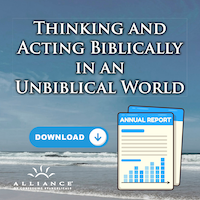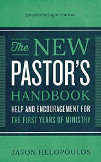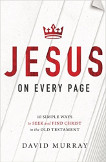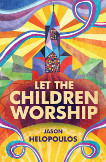
We See Jesus: New Testament Use of the Old in Hebrews 1:4-14
The Puritan theologian, Thomas Manton, once said: “The great skill of Christians is to find the New Testament prefigured in the Old, and the Old Testament fulfilled in the New Testament." What helps us most in this endeavor is that it doesn’t take long when reading through the NT to come across one of the 250+ citations of the OT. As we study the way in which the Apostles interpreted the OT we actually discover the Holy Spirit’s infallible interpretation of the OT passage. The principles of interpretation that we glean from the apostolic examples then serve as a guideline for how we ought to interpret other portions of the OT.
Of the NT books that cite portions of the OT almost none is so full and instructive as that of the letter to the Hebrews. In the first chapter alone we find 7 OT citations given in close proximity to one another. These 7 OT texts are strung together in verses 5-14. It may seem overwhelmingly tiring to spend time unpacking these citations, but it will prove to be one of the most rewarding theological studies to our spiritual life. Before we can talk about the personal benefit of carefully studying these OT citations, it’s necessary for us to have the guidelines by which we may enter into such a study.
Here are six steps that will help us deepen our understanding the OT citations in Hebrews 1:5-14:
1. Consider the flow of the chapter
Hebrews 1 highlights the glories of Jesus Christ. He is said to be better than the Old Testament prophets (vv. 1-4); Heir of all things; the brightness of the Father’s glory, the exact representation of His Person, the One who made all things, the One who providentially carries everything along, the One who single-handedly made purification of our sins and the One who sat down on the throne of God (vv. 1-4). He is finally said to be better than the Angels (1:5). The seven OT citations are introduced in verse 5 to defend why and how Christ is better than the Angels.
2. Consider the way in which the OT citations are introduced
The citations in vv. 5-14 are introduced by a reference to God the Father speaking to and about the Son. In vv. 6-7 He speaks to and about the Angels because the writer is showing that the Son was always better than the Angels. This is proved from what the Father says to and about the Son and the Angels in the OT. There is a Divine dialogue occurring between the Father and the Son in vv. 5, 8-9, 10-12, and 13.
The OT citations in Heb. 1:8-12 are some of the most important in the New Testament because they draw attention to the fact that God the Father addresses Jesus as “God.” In verse 8, God the Father says to God the Son, “‘Your throne, O God,” and in verse 10 He calls the Son, “LORD” (i.e. Yahweh). Jesus is God and LORD. He is fully God as the Father is fully God. In essence we are listening in on a dialogue between God the Father and God the Son about Himself!
3. Consider their original context
This is far and away the most time-consuming aspect of studying the NT use of the OT, but it is also that by which the most riches will be uncovered. Learning the original context of the citations is every bit as important as learning the NT context in which they are found. If you have a good English translation of Scripture you will probably find a small letter (e.g. a small [d]) beside the indented or italicized OT passage. If you look in the side column of your Bible you will find the OT reference from which the citation is made. Most English Bibles with this apparatus are fairly accurate with regard to the OT reference. When you go to the chapter from which it originally appears, take the time to read the entire chapter in which the reference is found.
In Heb. 1:5 the writer cites two OT texts having to do with the Sonship of Jesus.The first citation is taken from Psalm 2 and the second from 2 Samuel 7. The first of these (Psalm 2:7) has the Father speaking to the Son regarding His Sonship. The second (2 Samuel 7:14) is part of the Davidic Covenant where God promised David that one of his descendants would sit on his throne forever. Both passages speak of the Son sitting on the throne of God. We can therefore conclude that “the throne of David” is shorthand for “the throne of God.” Both passages have the ascension in view. Both passages are directly related to the statement of Heb. 1:4 that the Son “sat down at the right hand of the Majesty on High.” Accordingly, we can conclude that in its ultimate sense, Psalm 2 and 2 Samuel 7 are about Jesus—not David. At least, this is how the Apostles, under inspiration of the Holy Spirit, interpret these two OT texts.
4. Consider any differences between the wording of the OT Text and the way it is used in the NT.
While you will be able to discern some of the differences by using a good English translation (i.e. ESV, NKJV or NASB) you will most likely need to use other reference volumes. Two of the more helpful volumes are G.K. Beale and D.A. Carson ed. Commentary on the New Testament Use of the Old Testament and Patrick Fairbairn’s appendix on the NT use of the OT in his Hermeneutical Manual.
5. Consider the relationship between each OT text that is cited in the chapter or immediate context.
The next thing we need to consider is the way in which all of the OT texts strung together relate to one another. The Holy Spirit has strategically placed every OT citation in proximity to the other OT citations. Each one takes its place like a colorful thread in a carefully woven tapestry.
6. Draw conclusions about why this specific OT passage was chosen after you’ve considered the previous steps.
It takes us trying to get into the mind of the writer at this point. This is one of the more difficult aspects of biblical interpretation. We need to try to ascertain why the human author picked the specific texts that he did to prove the specific point he was trying to make. This will also help you as a student of Scripture. We need to learn to think like the biblical authors—even as we learn to think God’s thoughts after Him as they are revealed in Scripture.
- We grow in our reading of the OT by reading the NT citations of these portions of the OT.
- We learn that the majority of OT citations in the NT are Christological. They reveal that the OT is about Jesus Christ or some aspect relating to His death or resurrection.
- We should come to depend on the Savior more fully in our lives as we become more Christ-centered in our biblical interpretation.
- We will value the OT more as a vital part of our Christian life.
- We will learn to value the context in which every verse of Scripture was placed.
- We will grow in our faith and confidence in God as we discover the wisdom of His revelation—each text revealing yet another aspect of the perfections of our Redeemer.
Further Helps
D.A. Carson mp3 Lectures:
Hard Texts: Why Does Hebrews Cite the Old Testament Like That? (Part 1)
Hard Texts: Why Does Hebrews Cite the Old Testament Like That? (Part 2)
Hard Texts: Why Does Hebrews Cite the Old Testament Like That? (Part 3)
G.K. Beale and D.A. Carson ed. Handbook on the New Testament Use of the Old Testament. (A PDF of sample chapter can be found here).
“New Testament Use of the Old Testament” (at the Crossway Blog)
David Powlison Seeing With New Eyes (Phillipsburg, NJ: P & R Publishing, 2003) pp. 22-30



















 © Alliance of Confessing Evangelicals
© Alliance of Confessing Evangelicals


